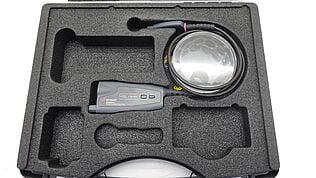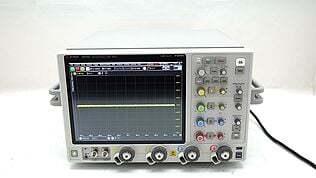- Introduction
- The Essence of a Trigger Circuit
- Types of Trigger Circuits
- Schmitt Trigger
- Monostable Multivibrator
- Astable Multivibrator
- Bistable Multivibrator
- Types of Trigger Circuit Inputs
- Application of Trigger Circuits
- Understanding Trigger Circuit Design Principles
- Fundamentals of Trigger Circuit Design
- Component Selection
- Simulation and Testing
- Considering Environmental Factors
- Troubleshooting Common Trigger Circuit Issues
- Irregular Output
- False Triggering
- Unstable Operation
- Inaccurate Timing
- Conclusion
- Whenever You’re Ready, Here Are 5 Ways We Can Help You
- Browse Our Latest Deals of Used Oscilloscopes
Since Jack Kilby's groundbreaking work on the first integrated circuit, a tiny innovation that has had a profound impact on our world, the realm of electronics continues to captivate us. Many fundamental components have emerged over time, helping us decipher this complex field.
Among them, one stands out for its profound, yet often overlooked role: the trigger circuit. An invisible hand that dictates when certain processes should initiate, a trigger circuit is ubiquitous in our technology-driven existence.
Buy Oscilloscopes at a Great Discount
The Essence of a Trigger Circuit
A trigger circuit is an essential element in electronics that determines when an event will occur. It's a type of switch that is activated by an input signal or series of signals. This signal could be anything from a specific voltage level, a change in current, or a timing signal. When the set condition is met, the trigger activates and performs a certain action, such as starting or stopping a process, sending a pulse, or causing a shift in output state.
Just as a conductor raises his baton to commence an orchestral performance, a trigger circuit initiates a series of electronic events leading to a specific outcome. This act of cueing the start or termination of a sequence is a key function in many electronic devices and systems, spanning from oscilloscopes to microcontrollers. Just like a symphony relies on the conductor's timely cues, our electronic world relies heavily on the precise timing provided by trigger circuits.
| Key Takeaway |
|---|
| Trigger circuits play a pivotal role in various electronic systems by dictating the precise timing of operations. Their profound impact spans from stabilizing waveforms in oscilloscopes to managing processes in microcontrollers, making them an essential cog in the machine of modern technology. |
Types of Trigger Circuits
There are several types of trigger circuits, each with unique properties and uses. Here's a brief description of some of the most commonly used trigger circuits:
Schmitt Trigger
A Schmitt trigger is used to convert an analog signal into a digital one. It has a specific threshold voltage at which the output switches from one state to another. This circuit has two threshold levels: the upper and lower threshold. The output changes state between these two levels, providing hysteresis and noise immunity. Schmitt triggers are especially useful in signal conditioning and waveform generation.
Monostable Multivibrator
A monostable multivibrator, also known as a one-shot multivibrator, is a trigger circuit that has one stable state. When triggered, it switches to an unstable state for a predetermined period before reverting to its stable state. This type of trigger circuit is commonly used in pulse generation and timing applications.
Astable Multivibrator
Unlike the monostable multivibrator, an astable multivibrator has no stable state. It continuously oscillates between two states without any external triggering. The period of oscillation can be controlled through the circuit's components. This circuit finds its use in oscillators and frequency generators.
Bistable Multivibrator
A bistable multivibrator, also known as flip-flop, has two stable states. It can switch from one state to another upon receiving an appropriate trigger signal. Flip-flops are widely used in digital electronics for data storage, data transfer, latch, register, and counter applications.
| Type of Trigger Circuit | Number of Stable States | Trigger Required | Common Applications |
|---|---|---|---|
| Schmitt Trigger | 1 | Yes | Signal conditioning, Waveform generation |
| Monostable Multivibrator | 1 | Yes | Pulse generation, timing applications |
| Astable Multivibrator | 0 | No | Oscillators, Frequency generators |
| Bistable Multivibrator (Flip-Flop) | 2 | Yes | Data storage, data transfer, latch, register, counter applications |
Types of Trigger Circuit Inputs
Trigger circuits can have different types of inputs. Some of the most common include:
- Voltage Trigger: Triggers when a specific voltage level is reached.
- Current Trigger: Triggers when a certain current level is attained.
- Edge Trigger: Triggers on the rising or falling edge of a signal.
- Delay Trigger: Triggers after a set period has passed since receiving the input signal.
Application of Trigger Circuits
Trigger circuits are used across an array of domains in the electronics field. Here are just a few instances where their role is vital:
- Oscilloscopes: In oscilloscopes, trigger circuits help stabilize a repeating waveform by providing a starting point for each sweep. They ensure that the waveform appears stationary on the oscilloscope display.
- Microcontrollers: In microcontrollers, they initiate processes or operations based on specific conditions. This could include starting an ADC conversion, triggering an interrupt, or starting/stopping a timer.
- Signal generators and analyzers: They are used to synchronize the output waveforms or analyze input signals based on certain triggering conditions.
- Power electronics: In power electronic devices like inverters and converters, trigger circuits control the switching devices to ensure the correct sequence of operation.
- Communication systems: They play a crucial role in synchronizing the transmission and reception of data in communication systems.
Understanding Trigger Circuit Design Principles
Diving into the design principles of trigger circuits allows us to better understand how these fascinating devices operate. The ability to build and manipulate trigger circuits with precision hinges on a strong understanding of these principles.
Fundamentals of Trigger Circuit Design
Trigger circuits are primarily based on the concept of feedback. The input signal is often sampled and compared to a reference value, and the result of this comparison is fed back to the control mechanism to dictate the output state of the circuit.
For instance, in the case of the Schmitt trigger, hysteresis is implemented through positive feedback. Two threshold levels are defined:
- One for transitioning from a low to high state (the positive edge)
- One for transitioning from high to low (the negative edge).
This mechanism allows for noise immunity, providing a clear, definitive digital output even from a noisy analog input.
Component Selection
Component selection is crucial when designing trigger circuits. This primarily includes selecting appropriate transistors, resistors, and capacitors that meet the desired operational criteria. These components influence crucial parameters like switching speed, power consumption, noise immunity, and stability, among others.
Simulation and Testing
Given the significant role that trigger circuits play in a system, it's crucial to test them rigorously. This process often involves simulating the circuit using software tools to verify its performance under various conditions. Subsequently, testing on a physical prototype helps validate real-world operation and reliability.
Considering Environmental Factors
Designers must consider the conditions under which the trigger circuit will operate. Factors like temperature, humidity, and electromagnetic interference can impact the circuit's performance. Consequently, appropriate measures, such as temperature compensation, shielding, and choice of robust components, should be factored into the design process.
Troubleshooting Common Trigger Circuit Issues
Even the best-designed trigger circuits can experience issues. Understanding common problems and how to solve them can save valuable time and resources. Here are some typical problems that arise and effective strategies for addressing them.
Irregular Output
An inconsistent or irregular output is a common problem. This can often be attributed to a faulty component or a poorly designed feedback loop.
Solution: Start by examining the components. Use a multimeter to check for any resistors or capacitors that may not be functioning correctly. Inspect transistors for any visible damage. If the components seem to be working fine, re-examine your feedback loop design.
False Triggering
False triggering is another frequent issue, usually caused by noise or interference. This can lead to the circuit toggling states at undesired moments.
Solution: To mitigate this, consider adding a noise filter or a Schmitt trigger to help clean up the signal. In some cases, shielding the circuit or moving it away from sources of electromagnetic interference may be necessary.
Unstable Operation
Unstable operation, where the circuit frequently oscillates between states without a trigger, can also occur. This is often due to the circuit being too sensitive or the power supply being unstable.
Solution: Try adjusting the values of the resistors and capacitors to make the circuit less sensitive. If that doesn't work, check your power supply for stability. Consider using a voltage regulator to ensure a consistent voltage supply.
Inaccurate Timing
In some applications, accurate timing is critical. If the timing is off, it can be due to incorrect resistor or capacitor values or variations due to environmental factors.
Solution: Double-check your calculations for the resistor and capacitor values. Remember that real components may not match their nominal values exactly. Also, consider environmental factors, such as temperature, which can influence component values.
Being able to troubleshoot common issues with trigger circuits not only makes you more self-reliant but also deepens your understanding of these devices.
Conclusion
Trigger circuits are powerful orchestrators of timing and sequence. From stabilizing waveforms and managing microcontrollers to enhancing noise immunity and enabling data storage, these innovations subtly but significantly impact our technology-driven world.
By understanding design principles, strengths and weaknesses, and troubleshooting techniques, electrical engineers and related professionals can fully utilize the potential of these devices.
Understanding and mastering trigger circuits, however, is not just about theoretical knowledge – it's also about practical application. This is where having reliable and precise testing equipment becomes crucial. If you're looking to purchase or upgrade your testing tools, consider Keysight's Used Equipment Store.
Choose from a variety of high-quality pre-owned testing equipment like oscilloscopes, signal analyzers, and network analyzers that can aid you in designing, testing, and refining your trigger circuits. Delve into the world of trigger circuits with confidence with Keysight by your side.

Whenever You’re Ready, Here Are 5 Ways We Can Help You
- Browse our Premium Used Oscilloscopes.
- Call tech support US: +1 800 829-4444
Press #, then 2. Hours: 7 am – 5 pm MT, Mon– Fri - Talk to our sales support team by clicking the icon (bottom right corner) on every offer page
- Create an account to get price alerts and access to exclusive waitlists.
- Talk to your account manager about your specific needs.

Subscribe to Get Our Latest News, Updates, and Articles.
Browse Our Latest Deals of Used Oscilloscopes
Select up to 3 instruments to compare
Enable Notifications
In order to use this feature, you need to enable notifications.
Manage notification preferences













































